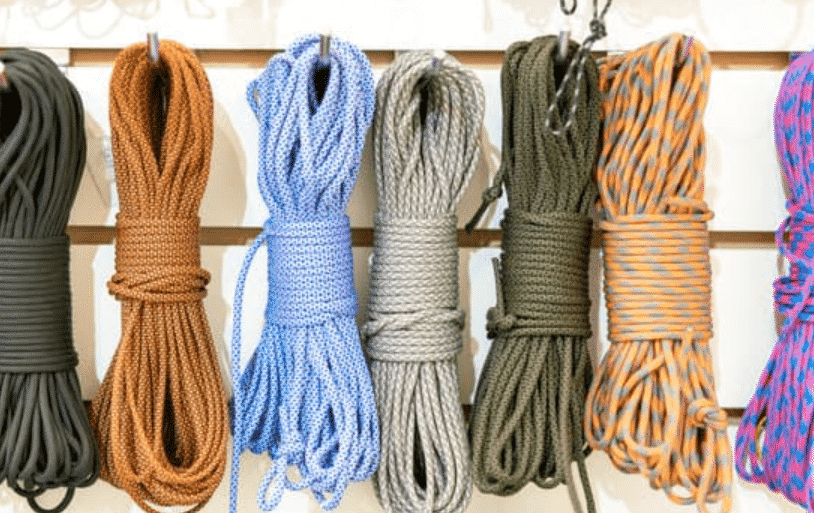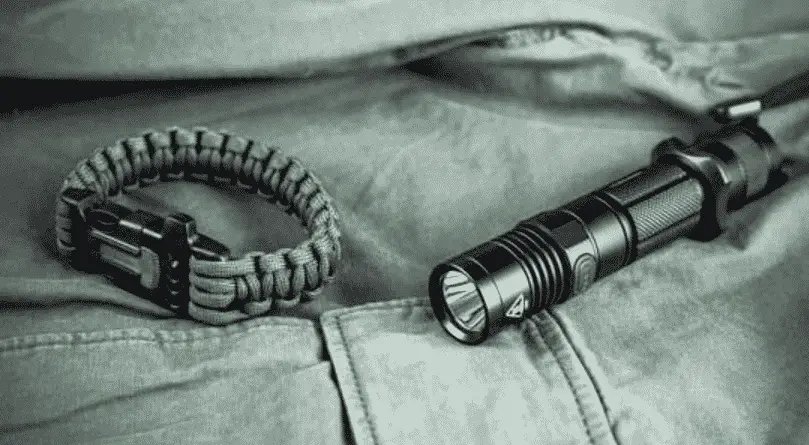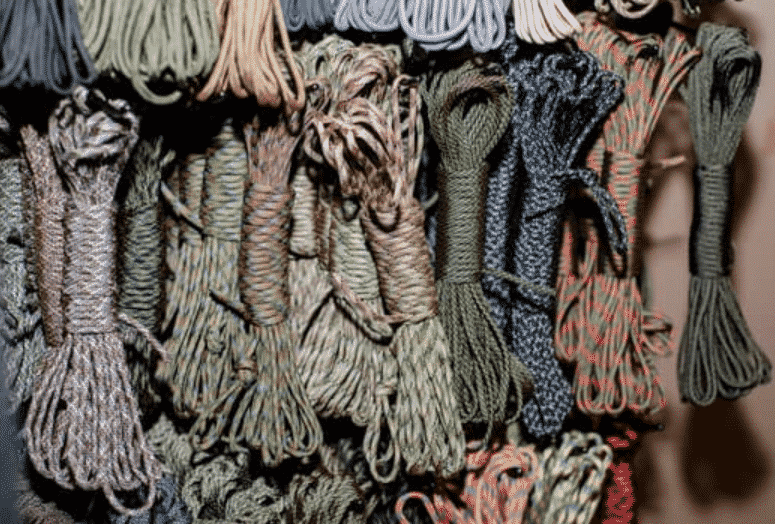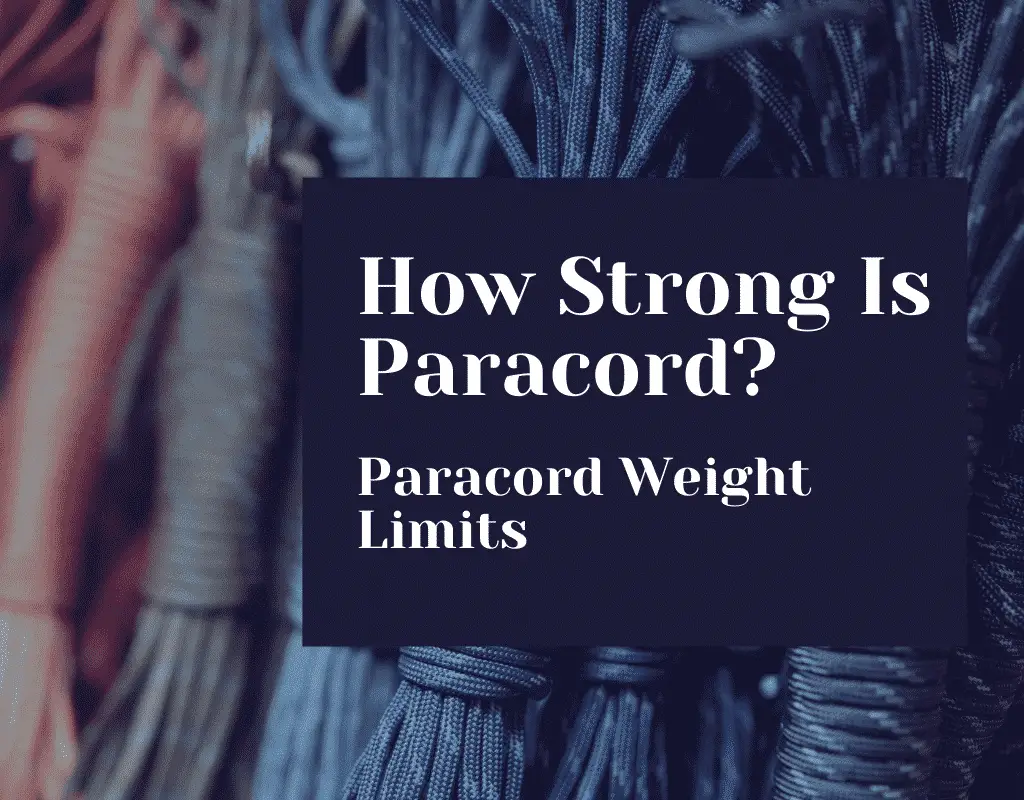Have you ever wondered how much weight paracord can hold? Paracord is considered an essential piece of survival gear, but people rarely understand the working strength of paracord. You won’t be able to get the most out of paracord without getting a better understanding of its weight limits. How Strong Is Paracord? What’s paracords weight limit?
The most commonly sold type of paracord is called paracord 550, but there stronger/weaker cords available. As the name implies paracord 550 has a static load rating of 550 pounds, but that’s much higher than its effective working weight. The safe working load of paracord is 20-30 percent of the total weight rating. So 550 paracord has a maximum safe working load of around 110-165 lbs.
There are a lot of different types of paracord with different strength ratings. Lets go into a few of the different uses of paracord, go over strength ratings, and explain the difference of static load ratings versus working loads.
Table Of Contents
How Much Weight Will Paracord Hold? How Much Weight Can Paracord Support?
There are lots of many different types of paracord in various strengths and weight ratings. Most people are familiar with commercial type III paracord 550 (7 Strand). It has the same size/rating as the old style mil spec paracord that was used in parachutes during World War II.
Over the past couple of decades the military has transitioned to Military Type III (aka Type 4) Paracord 750 (11 Strand). It’s heavier and a little bit thicker than standard paracord 550 so it has a stronger 750lb static load rating and 150-225lb working load rating.
There are also the lower and upper extremes with varying weight ratings. At the lower end you have micro 90 paracord (18-27lb working load), for light tasks and mostly decorative purposes. The upper end goes up to heavy duty paracord 1100 (220-330lb working load), 2650lb (530-795lb) and 3000lb (600-900lb) ratings.
Paracord planets 5/16 inch 3000lb tensile strength Paramax cord is the strongest paracord I’ve came across, but it’s thick and ridiculously heavy. Just make sure you choose the right size from the drop down menu since it comes in various strengths/sizes.
Paracord Strength Chart

Here’s a quick chart to break down the static load and working load of various paracord styles. Just understand that force multiples fast on a falling object (I’ll explain below). So even if the weight falls within the working load range, your line can snap with a short fall.
All it would take is a 2-3ft drop to snap for a 200lb object to snap an 1100lb line. There are still ways to use heavy duty paracord 1100 within the weight range, but you need to be careful.
| Paracord Type | Static Load (Snapping Weight) | Working Load (Constant Weight) |
|---|---|---|
| Micro Paracord 90 | 90 lb | 18-27 lb |
| Paracord 275 | 275 lb | 55-82.5 lb |
| Paracord 325 | 325 lb | 65-97.5 lb |
| Paracord 425 | 425 lb | 85-127.5 lb |
| Paracord 550 (Commercial or Mil-Spec Type 3) | 550 lb | 110-165 lb |
| Paracord 650 | 650 lb | 130-195 lb |
| Paracord 750 (Commercial or Mil-Spec Type 4) | 750 lb | 150-225 lb |
| Paracord 1100 | 1100 lb | 220-330 lb |
| Paracord 2650 | 2650 lb | 530-795 lb |
| Paracord 3000 | 3000 lb | 600-900 lb |
How Is Paracord Strength Measured? What Does Minimum Strength Mean With Paracord?

Paracord is measured with two types of measurements. You have the static load measurement (aka tensile strength or minimum breaking strength) that tells the snapping strength of the cord, and the working load measurement that gives a recommendation of safe working weights.
- Static Load: Static load is the maximum weight that the paracord can hold in a fixed or stationary position. This is the weight rating that’s listed in the name. Manufacturers take a length of cord attached to a fixed object and pull until it snaps. There’s usually 20-30% of wiggle room in the static load rating to make up for manufacturing defects.
- Working Load: This is the recommend weight of objects that you should use paracord with in a fixed position. Using the working weight gives some wiggle room for friction and mild external forces. Think along the lines of tying down a tent, pulling a wagon on flat ground, tying gear to your pack, suspending a bearbag (without sudden drops), etc.. Any type of sudden drop will amplify the weight and could potentially lead to a snapped line.
Remember that thicker cord with more inner strands will almost always be stronger than thin cord. Paracord ranges in size from 1/14″ to 5/16″ so keep an eye on the thickness to get a better idea of the cord strength.
How Strong Is Paracord 550?

I won’t go over all of the different strength ratings since that would be overkill, but lets talk about paracord 550 since that’s the most popular strength rating. Paracord 550 can handle a static load of 550lb and a working load of 110-165 lbs, but what does that actually mean?
Honestly, that doesn’t mean much to the average person. Your lines can snap even if you’re trying to work with gear within the recommend working load rating. There are so many external factors that can affect the working weight and cause you to snap your lines.
Pulling an object up within the working weight range and holding it steady won’t cause any issues. Quickly dropping that same object 2-3 feet can amplify the load causing your paracord line to snap. So what does the weight rating actually mean and what can I do with paracord?
Paracord should only be used for securing static objects with very little chance of moving. Think about common camping tasks like securing an object to your pack, tieing down tents, setting up clotheslines, fixing gear, and securing a ridgeline of a shelter. You can use paracord for any task that will provide a stable load on the cord.
It should never be used for rappelling, climbing, lifting heavy objects, or for setting up a camping hammock. You need to use a rope that can stretch and handle uneven pressure for those kinds of tasks. Paracord might work for suspending objects in the short term, but you have to be extremely careful to avoid sudden drops and shifting weight.
Does It Matter If My Paracord Is MilSpec?

Paracord manufacturers like to label their cord as mil-spec, but that doesn’t mean much. The military inspects government purchased cords, but there’s no governing body that deals with paracord purchased on the civilian market.
Any 550lb paracord can be labeled as Type 3 Mil-Spec and 750lb paracord can be labeled as Type 4 Mil-Spec. Whether or not the cord would actually pass military inspections depends on the manufacturer. That’s why you need to look into the manufacturer behind the cord and look for well trusted brands that stand behind their ratings.
There are lots of different manufacturers that sell bulk “mil-spec” paracord so it can be hard to choose between the different options. Paracord Planet (check out their paracord 550 spools) seems to be the best bulk paracord supplier and they sell large spools of paracord from 100ft-1000ft rolls at 2/3 of the price that you find at most outdoor gear stores.
There Are Many Factors That Affect Paracord Strength

There are many factors that affect paracord strength that you need to consider. What type of knot you’re using, angles, wetness, length, chemicals, cord age, and type of force all play a factor. Here’s a brief overview of the different factors that affect paracord strength.
- Paracord Thickness: Paracord thickness is by far the most important factor when it comes to paracord strength. The manufacturer plays a small role, but thicker cord will almost always be stronger than thinner designs.
- Strands In The Cord: Additional strands in the cord will improve overall strength. The minimum rating for paracord 550 to be considered mil-spec is 7 strands inside the line. Each additional strand you add spreads the load reducing the likelihood of catastrophic failure.
- Type of Knot: The type of knot you’re using plays a very important role on the strength of the cord. Each knot that you add to the paracord will reduce its strength. Not having a knot will give you 100% of the tensile strength rating, and a typical knot drops the rating into the 60-70% range. The Figure 8 knot is the best knot for maintaining cord strength at 80% of the total strength rating.
- Cord Age: Like most things in life, paracord gets weaker as the cord ages. Storing your paracord inside a temperature controlled environment will extend its age, but there aren’t any guidelines that tell you when paracord goes bad. Check for signs of dry rot, tears, discoloration, and try not to put unnecessary stress on the cord by working above the recommend working load rating.
- Chemicals: Keep your cord away from cleaning chemicals, bug spray, etc. If you need to clean dirt off your cord, scrub it down with mild soap and water. Try not to use an overly abrasive scrub brush that could damage the outer shell.
- Cord Length: When dealing with dynamic force (explained below), a longer line will add additional stress on the line. Think about the speed of a swinging pendulum. At the top of the pendulum the speed will be close to zero, at the lowest point the speed is at the fastest. So as you increase the length of the paracord line there will be a higher degree of speed, acceleration, and force on the line.
- Bends In The Cord: Wherever you bend a cord around an object adds a stress point on the cord. Hanging a cord over a tree branch puts more force over the branch than at the bottom of the cord. The cord is more likely to snap at bends and changes of angle position.
- Water: Water stretches out the fibers in paracord and significantly reduces strength. Most estimates put strength of wet paracord at 75% of the dry tensile strength.
- Type Of Force: There’s a difference between a stationary load and moving load. Tying an object in a stationary position won’t have as much force as dropping or swinging an object. I’ll explain the difference between static and dynamic force in the next section.
Static Force vs Dynamic Force
I mentioned this a little bit above, but when trying to figure out how strong paracord is you have to consider both dynamic and static force. Static force is any load that doesn’t change position, size, or direction (bear canister tied to your pack). Dynamic force is a moving load that will pull on your paracord (suspended bear bag dropping quickly).
Here’s a simple example: you suspend your hammock from a tree using paracord with a 550lb rating. If you slowly get on the hammock and you’re lying still that should be close to the static load so you won’t have any issues.
Plopping down on the hammock or swinging would create additional vertical and horizontal pressure (dynamic force). It doesn’t take much pressure to cause serious issues. A 200lb person dropping 2ft into a hammock can be enough to snap 550lb paracord line.
Dynamic force can cause serious issues if you don’t take it into account. Most paracord uses involve dynamic force, unless you’re tying down a stationary object (bear canister tied to pack). The wind blowing on a tent, pulling a bear bag up into a tree branch, etc., all use dynamic force.
Paracord Isn’t Strong Or Wide Enough For Climbing or Rapelling
Your body weight might fall into paracords safe working load, but it won’t be strong enough to support a persons body weight. Paracord 750 might have a safe working load in the 150-225 lb range, but that’s with a slowly moving load.
Mil Spec 750lb paracord will snap with a short 2-3 foot fall. I won’t go into detail of the physic required to calculate the force of a falling object (I majored in Physics at Ohio State), but here’s a quick example. A 180lb person (average weight of adult) falling 3ft will put 1806 lbs of force on the rope and if they drop 6ft it would be 3612 lbs of force.
You can quickly see where that would cause a serious problem. It would take 5 paracord 750 rating cords tied together to support a short 6 foot fall of an average sized person(man and women). That’s why the parachutes used in world war 2 that used paracord 550, had 24 different lines connected to the canopy to spread out the impact force.




